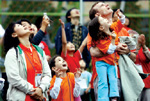
As of the end of 2007, South Korea's total population was estimated to be 48,456,369 with a density of 498 people per square kilometer. The population of North Korea was estimated to be 23,200,238.
Korea saw its population grow by an annual rate of 3 percent during the 1960s, but growth slowed to 2 percent over the next decade. In 2005, the rate stood at 0.21 percent and is expected to further decline to 0.02 percent by 2020.
In the 1960s, Korea's population distribution formed a pyramid, with a high birth rate and relatively short life expectancy. However, age-group distribution is now shaped more like a bell because of the low birth rate and extended life expectancy. Those aged 15 and younger will make up a decreasing portion of the total, while senior citizens (65 and older) will account for some 15.7 percent of the total by the year 2020.
The nation's rapid industrialization and urbanization in the 1960s and 1970s has been accompanied by continuing migration of rural residents into the cities, particularly Seoul, resulting in heavily populated metropolitan areas. However, in recent years, an increasing number of Seoulites have begun moving to suburban areas.
The number of foreigners ― including short-term sojourners ― residing in Korea reached 1,000,254, surpassing for the first time the one million mark, on Aug. 24, 2007. They now make up two percent of the population. And the yearly increase, in particular the 15 percent spurt from the foreign population of 865,889 recorded in July 2006, shows how rapidly Korean society is diversifying in terms of race and culture.
By nationality, Chinese made up 44 percent with 441,334 (266,764 of which were ethnic Koreans), followed by Americans who made up 12 percent with 117,938. Vietnamese comprised the third largest foreigners group at 6 percent with 63,464, followed by Filipinos. (5 percent with 50,264) and Thais (4 percent with 43,792). The others were mainly from Japan, Taiwan and Indonesia.
Among the 724,967 long-term residents, workers, including industrial trainees, made up 56 percent of the foreign population at 404,051. Those who came to Korea through marriage were 14 percent at 104,749, while 7 percent or 47,479 were students studying in Korea.